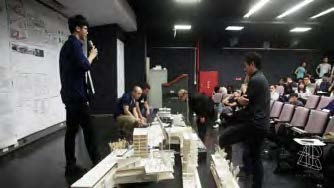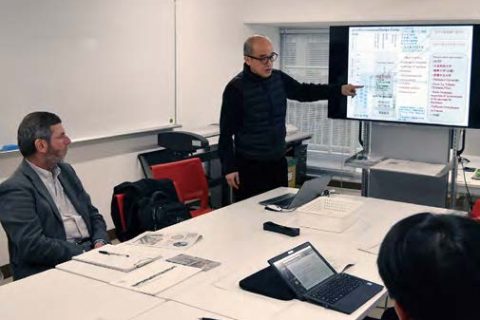On 13 May 2016, the National Taipei University of Technology (NTUT) invited six faculty members from the Faculty of Design, Kyushu University, to participate in the critique session for graduation design. Among the six faculty members were, Professor Doi (Director of Undergraduate Programme for the Department of Environmental Design), Professor Tani (Vice-Dean for the Faculty of Design), Associate Professor Ukai, Associate Professor Kishi, Associate Professor Inoue and Assistant Professor Iwamoto. The session started at around 9am, interceded by a lunch exchange-session with four of the Japanese counterparts. The critique session resumed at around 1.30pm and lasted till 7pm in the evening. Within 8 hours of critique session, graduation works from six students were assessed. Overall, the jury was made up of four- teen academics, namely from Japan (six academics), Taiwan (4 invited academics) and the rest were faculty members in the Department of Architecture, NTUT.
Through drawings and models, the students put their concepts and design methodologies across in Chinese. To help the Japanese academics understand the content of the presentation, faculty members from NTUT provided some simultaneous translation for key points in Japanese. While discussions on design related content was done in Chinese and English, certain details were supplemented by Chinese/Japanese translation. During the exciting discussion, some students seem to be nervous as they had to respond in English, which is a challenge for them. But with the assistance from the invited Taiwanese academics in offering some translations, students could understand the comments given by the Japanese visitors; and in turn, able to provide relevant responses related to their design concepts. While students found it difficult in communicating due to language differences, nonetheless, the fundamental communication method in architectural design should be based on concep- tual drawings. The lack of communication competencies in this case provided a good opportunity for students to under- stand the importance of conceptual drawings.
The critique session ended with concluding remarks and sharing of reflections and suggestions by Professor Doi and Associate Professor Ukai. This indeed had benefited the students in many ways. While perspectives on the same design situation may differ among academics from different countries, it is through this type of critique exchange that creates understanding on the international differences in architectural design. It is believed that both academics and students will find this form of experience extremely valuable.
(Reported by Lin Yu-Shang, NTUT)



